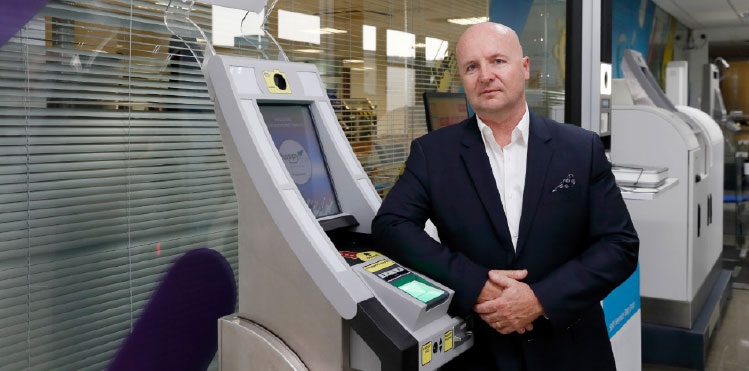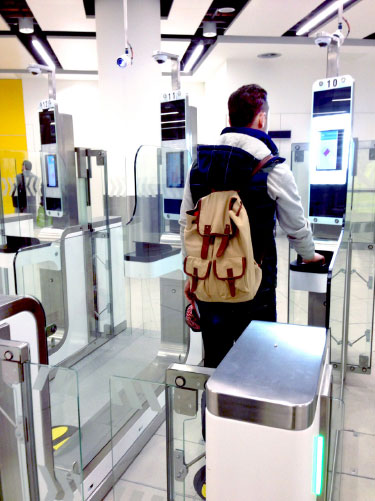
Miguel Leitmann, CEO of Vision-Box: “Vision-Box has an integrated approach to border control based on a unified software suite, the orchestration layer, which enables the implementation of an advanced border management solution, integrating all border control solutions and offering an overview of the security infrastructure, of a person’s identity, as well as flow management, with unlimited scalability.”
Miguel Leitmann, CEO of Vision-Box, interviewed by Samantha Jenkins, on how Automated Border Control can provide “a huge leap forward in the passenger experience”.
The expansion of Automated Border Control (ABC) solutions is helping provide a seamless, secure, passenger-centric experience. Today, Vision-Box has already implemented more than 1,000 Automated Border Control (ABC) solutions at land, sea and air borders around the world.
The border control portfolio aimed at airports, airlines and immigration authorities includes solutions addressing a variety of business scenarios, including security checkpoints, and self-boarding and ABC biometric eGates. “Every second, millions of images are being captured and processed by Vision-Box systems, installed right at the heart of the most prestigious organisations who trust our biometric identity and digital video management solutions for their critical applications,” says Miguel Leitmann, CEO of Vision-Box.
Vision-Box operates automated borders at more than 60 international airports, with over 3,000 electronic identity systems deployed across the globe, and Europe can be considered the world reference in ABC implementation. “Our eGates are helping airports and border control authorities in The Netherlands, United Kingdom, Norway, Finland, Estonia, Latvia, Portugal, and Denmark, among other countries,” explains Leitmann. “With our global presence and continuous expansion, we are targeting many more international airports and borders, not only to implement ABC solutions, but also broad, integrated ID management solutions that will improve crucial security patterns on a worldwide scale.”
Outside of Europe, one of Vision-Box’s reference projects is the nationwide rollout of ABC eGates at eight major international airports in Australia. Australia’s Customs and Border Protection Services have trialled the ABC technology at Brisbane Airport.
In Brazil, Vision-Box has deployed ABC eGates – as well as Bar-Coded Boarding Pass eGates at the security checkpoint area – at São Paulo-Guarulhos International Airport, which process over 40,000 passengers daily.
Several international US airports, notably Los Angeles, Miami, Las Vegas, Orlando, Boston, Atlanta, San Diego, Tampa, and Philadelphia, have all also employed Automated Passport Control (APC) kiosks.
All of the products in the Vision-Box border control portfolio are linked together through its unique IT platform ‘vb i-shield’, which enables the implementation of an advanced border management system and integrates with advanced digital video management solutions, intelligent biometric and biographic search engines, and danger management functionalities.
Leitmann highlights: “Our solutions are playing a very important social role: in modernising identity processes, making it easier; in improving security levels in border controls, discouraging fraud or illegal immigration; in improving information management; in facilitating travel for legitimate travellers, providing them with a positive travel experience.”
Self-service trend
Regular readers will recall our report on the launch of Aruba Happy Flow in the Summer issue of Airport Business. This innovative two-year pilot project serves as a pre-clearance initiative between Aruba and The Netherlands. Happy Flow uses facial recognition technology as the basis of a single passenger token, which recognises passengers at every step of their journey from check-in to boarding.
Vision-Box is the lead contractor on the project, provides the Happy Flow infrastructure, and will showcase Happy Flow at this year’s ACI Airport Exchange. Updating Airport Business on progress since our initial briefing, Leitmann explains: “Happy Flow is about using a single token to improve the passenger experience, and at the same time all the airport stakeholders increase security and efficiency. Airports are intensifying the modernisation of their infrastructure and self-service is the trend that the airport of the future is following.”
In the first six months of the project, over 5,600 passengers from 26 countries have used Happy Flow. “The potential for Happy Flow to be implemented in worldwide airports is massive,” Leitmann adds. “KLM and Schiphol Group are already undertaking a feasibility study on how Happy Flow could be implemented at Amsterdam Airport Schiphol.”
In future, there could be a broader goal of expanding the pre-clearance to all 26 Schengen member countries and, according to Leitmann: “There’s no technical reason why it should not be used by other passengers, other airlines and other airports. It’s a question of orchestration.”
Looking ahead, the Happy Flow mobile check-in app will allow passengers to check-in, enroll their biometrics once, provide their Advance Passenger Information (API) early, and authenticate their document before arriving at the airport to be able to use Happy Flow without stopping at the check-in kiosk.

More than 1,000 of Vision-Box’s Automated Border Control (ABC) kiosks and passenger experience solutions have been implemented at land, sea, and air borders around the world, and it operates in more than 60 international airports with over 3,000 electronic identity systems.
Future challenges
Vision-Box has a constant drive for innovation and has identified four key challenges. The first of these is automating border control processes through ABC technology in combination with Advance Passenger Information System (APIS) and Passenger Name Registration (PNR). “The results of widespread ABC implementation are remarkable, as it has proved to deliver benefits to all parties involved in the process,” notes Leitmann. “Nonetheless, totally automated processes in airports and border control points is where the greater challenge remains: generalised self-service processes based on paperless travel and touchless interactions.”
Leitmann says the next challenge is the integration of borders at both a national and international level, followed by taking ABC to the next level: “Biometric-enabled ABC solutions may leverage projects that will enhance global security and facilitation, such as the implementation of Smart Borders, Entry Exit Systems (EES), Registered Traveller Programmes (RTP), pre-clearance initiatives, and more to come.”
The fourth challenge, according to Leitmann, is facilitating travel: “While technology can improve processes and overall security, it is crucial that innovative ABC solutions take into consideration the human factor. ABC solutions should be carefully designed to be attractive, engaging and ergonomic, even proactively adjusting to the traveller. Software interfaces should be intuitive and friendly, providing relevant instructions and constant feedback to users.”
“End-to-end solution to transform passenger journey”
Looking ahead with a holistic view, Vision-Box is investing in other groundbreaking initiatives, including end-to-end passenger experience solutions to improve passenger flow, and pre-clearance initiatives to enhance the collaboration between countries and improve overall security. “With a long track record and experience in Automated Border Control and passenger experience, we are certain that self-service is the approach that will become the standard in the coming years. Vision-Box is helping airports around the world to improve passenger processing and it is already anticipating the future with the definition of an end-to-end solution that will transform the passenger journey into a sequence of user-centric service touch points,” Leitmann concludes.







